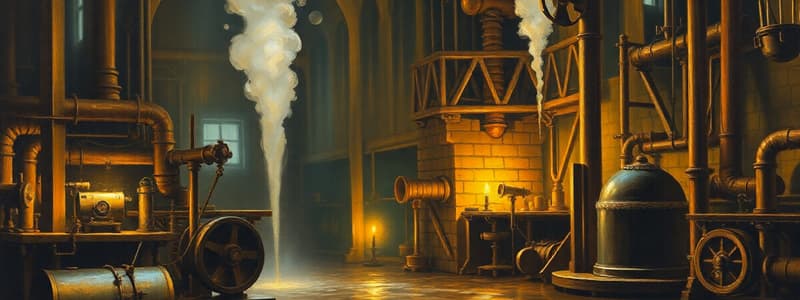Podcast
Questions and Answers
What is the main application of steam in chemical plants?
What is the main application of steam in chemical plants?
- Generating electricity
- Heating process streams (correct)
- Cooling process streams
- Fuel for furnaces
The 1980s marked the beginning of environmental catalysis.
The 1980s marked the beginning of environmental catalysis.
True (A)
What is the primary raw material used in the petrochemical industry?
What is the primary raw material used in the petrochemical industry?
Crude Oil
The largest volume chemical produced is __________.
The largest volume chemical produced is __________.
Match the following eras or innovations with their primary focus:
Match the following eras or innovations with their primary focus:
What is the primary role of chemical engineers?
What is the primary role of chemical engineers?
Electrical engineering is a core discipline of chemical engineering.
Electrical engineering is a core discipline of chemical engineering.
What is a grand challenge facing chemical engineers today?
What is a grand challenge facing chemical engineers today?
The law of conservation of ______ is a fundamental principle of chemical engineering.
The law of conservation of ______ is a fundamental principle of chemical engineering.
Match the following challenges with their descriptions:
Match the following challenges with their descriptions:
Which of the following is an importance of chemical engineering in medicine?
Which of the following is an importance of chemical engineering in medicine?
The Industrial Revolution decreased the demand for chemical products.
The Industrial Revolution decreased the demand for chemical products.
What is the primary goal of reverse engineering the brain?
What is the primary goal of reverse engineering the brain?
Understanding the motivation behind a chemical process is necessary for effective process design.
Understanding the motivation behind a chemical process is necessary for effective process design.
Which industry is one of the oldest and plays an important role in social, cultural, and economic growth?
Which industry is one of the oldest and plays an important role in social, cultural, and economic growth?
Who was the first chemist to synthesize an organic chemical for commercial use?
Who was the first chemist to synthesize an organic chemical for commercial use?
Match the following chemical diagrams with their primary usage:
Match the following chemical diagrams with their primary usage:
Block diagrams are more detailed than process flow diagrams.
Block diagrams are more detailed than process flow diagrams.
The most important utility system in most chemical plants is _____ which is essential for processes.
The most important utility system in most chemical plants is _____ which is essential for processes.
What is the choice of system definition for a chemical process based on?
What is the choice of system definition for a chemical process based on?
What is the primary purpose of piping and instrumentation diagrams (P&IDs)?
What is the primary purpose of piping and instrumentation diagrams (P&IDs)?
What is the purpose of providing detailed information on piping, instrumentation, and control systems?
What is the purpose of providing detailed information on piping, instrumentation, and control systems?
A batch process operates continuously without a fixed start or end time.
A batch process operates continuously without a fixed start or end time.
What is one key characteristic that differentiates a steady-state process from a transient process?
What is one key characteristic that differentiates a steady-state process from a transient process?
_________ processes have constant conditions, while transient processes experience changes over time.
_________ processes have constant conditions, while transient processes experience changes over time.
Why is it important to understand the motivation behind a chemical process?
Why is it important to understand the motivation behind a chemical process?
Material balances are essential for ensuring the conservation of mass in chemical processes.
Material balances are essential for ensuring the conservation of mass in chemical processes.
Match the following concepts with their significance in chemical processes.
Match the following concepts with their significance in chemical processes.
What is a key reason for accurately representing chemical processes using flow diagrams?
What is a key reason for accurately representing chemical processes using flow diagrams?
Which process is associated with the birth of the modern chemical industry?
Which process is associated with the birth of the modern chemical industry?
What are the two most important inorganic base chemicals?
What are the two most important inorganic base chemicals?
The invention of the automobile sparked the demand for aromatics.
The invention of the automobile sparked the demand for aromatics.
Which chemical process was developed by Houdry in 1936?
Which chemical process was developed by Houdry in 1936?
What is the primary focus of the chemical industry in the age of sustainability?
What is the primary focus of the chemical industry in the age of sustainability?
The process that involves the transformation of crude oil into useful chemicals is known as __________.
The process that involves the transformation of crude oil into useful chemicals is known as __________.
Which of the following is NOT an example of an inorganic chemical?
Which of the following is NOT an example of an inorganic chemical?
Match the following processes with their significance:
Match the following processes with their significance:
Which process is used to produce light alkenes from natural gas?
Which process is used to produce light alkenes from natural gas?
The main use of fuel oil in refineries is to generate electricity.
The main use of fuel oil in refineries is to generate electricity.
What chemical process is associated with the production of high-octane aviation fuel during WWII?
What chemical process is associated with the production of high-octane aviation fuel during WWII?
The chemical industry's main environmental concern in the 21st century is __________ greenhouse gas emissions.
The chemical industry's main environmental concern in the 21st century is __________ greenhouse gas emissions.
Which of the following is an example of an organic chemical?
Which of the following is an example of an organic chemical?
The primary focus of the chemical industry today is to expand petrochemical processes.
The primary focus of the chemical industry today is to expand petrochemical processes.
Match the following processes with their descriptions:
Match the following processes with their descriptions:
Flashcards
Chemical Engineer's Role
Chemical Engineer's Role
Chemical engineers design and operate chemical plants, conduct research in chemistry laboratories, and develop new medicines.
Core Disciplines of Chemical Engineering
Core Disciplines of Chemical Engineering
Core disciplines of chemical engineering include thermodynamics, mass transfer, and fluid mechanics.
Impact of the Industrial Revolution
Impact of the Industrial Revolution
The Industrial Revolution spurred the growth of chemical engineering by driving the need for new chemical processes, increasing demand for chemical products, and shifting production from batch to continuous processes.
Grand Challenges in Chemical Engineering
Grand Challenges in Chemical Engineering
Signup and view all the flashcards
Chemical Engineering's Importance in Medicine
Chemical Engineering's Importance in Medicine
Signup and view all the flashcards
Professional Activities of Chemical Engineers
Professional Activities of Chemical Engineers
Signup and view all the flashcards
Reverse Engineering the Brain
Reverse Engineering the Brain
Signup and view all the flashcards
Challenges in Solar Energy Economics
Challenges in Solar Energy Economics
Signup and view all the flashcards
Steam's Main Application
Steam's Main Application
Signup and view all the flashcards
Birth of Environmental Catalysis
Birth of Environmental Catalysis
Signup and view all the flashcards
Petrochemical Industry's Raw Material
Petrochemical Industry's Raw Material
Signup and view all the flashcards
Largest Volume Chemical
Largest Volume Chemical
Signup and view all the flashcards
1980s Chemical Industry Focus
1980s Chemical Industry Focus
Signup and view all the flashcards
Chemical Process Motivation
Chemical Process Motivation
Signup and view all the flashcards
System Definition Importance
System Definition Importance
Signup and view all the flashcards
Block vs. Flow Diagrams
Block vs. Flow Diagrams
Signup and view all the flashcards
P&ID Use
P&ID Use
Signup and view all the flashcards
Flexible System Definitions
Flexible System Definitions
Signup and view all the flashcards
Oldest Industry
Oldest Industry
Signup and view all the flashcards
First Synthetic Organic Chemical
First Synthetic Organic Chemical
Signup and view all the flashcards
Essential Chemical Plant Utility
Essential Chemical Plant Utility
Signup and view all the flashcards
Process Flow Diagram (PFD)
Process Flow Diagram (PFD)
Signup and view all the flashcards
Steady-State Process
Steady-State Process
Signup and view all the flashcards
Transient Process
Transient Process
Signup and view all the flashcards
Material Balance
Material Balance
Signup and view all the flashcards
Open System
Open System
Signup and view all the flashcards
Why is understanding process motivation important?
Why is understanding process motivation important?
Signup and view all the flashcards
System Definition
System Definition
Signup and view all the flashcards
Importance of Flow Diagrams
Importance of Flow Diagrams
Signup and view all the flashcards
Steam Cracking
Steam Cracking
Signup and view all the flashcards
Fuel Oil's Role
Fuel Oil's Role
Signup and view all the flashcards
Catalytic Cracking
Catalytic Cracking
Signup and view all the flashcards
Chemical Industry's Main Concern (21st Century)
Chemical Industry's Main Concern (21st Century)
Signup and view all the flashcards
Organic Chemical
Organic Chemical
Signup and view all the flashcards
Sustainability's Focus (Chemical Industry)
Sustainability's Focus (Chemical Industry)
Signup and view all the flashcards
High-octane Aviation Fuel (WWII)
High-octane Aviation Fuel (WWII)
Signup and view all the flashcards
Why is Catalytic Cracking so important?
Why is Catalytic Cracking so important?
Signup and view all the flashcards
Leblanc Process
Leblanc Process
Signup and view all the flashcards
Sulfuric Acid and Ammonia
Sulfuric Acid and Ammonia
Signup and view all the flashcards
What sparked the demand for aromatics in the 19th century?
What sparked the demand for aromatics in the 19th century?
Signup and view all the flashcards
Sustainability Focus in the Chemical Industry
Sustainability Focus in the Chemical Industry
Signup and view all the flashcards
What is NOT an inorganic chemical?
What is NOT an inorganic chemical?
Signup and view all the flashcards
Study Notes
Chemical Engineering Fundamentals
- Chemical engineers design and operate chemical plants, conduct research in chemistry labs, and develop new medicines.
- Core disciplines of chemical engineering include thermodynamics, mass transfer, and fluid mechanics. Electrical engineering is not a core chemical engineering discipline.
- The Industrial Revolution was significant to chemical engineering because it led to the development of new chemical processes, increased demand for chemical products, and shifted production from batch to continuous processes.
- Grand challenges facing chemical engineers today include developing sustainable energy sources, providing clean water, and addressing climate change.
- Chemical engineering is vital to medicine for developing new drugs and medical devices, improving medical diagnostics, and ensuring the safety of medical products.
- Professional activities in chemical engineering include process development research, technical sales, and plant design/construction.
- The primary goal of reverse-engineering the brain is understanding how the brain works, creating artificial intelligence, and treating brain disorders.
- Key challenges in making solar energy economical include the high cost of solar panels, intermittency of solar power, and lack of storage solutions.
- Chemical engineers contribute to environmental protection, through developing pollution control technologies, designing sustainable processes, and assessing environmental impact.
- Fundamental principles of chemical engineering include the law of conservation of mass and the law of conservation of energy. The ideal gas law is also a fundamental principle.
- A block diagram in chemical processing provides a simplified overview of equipment arrangement and the flow of materials/energy. A process flow diagram (PFD) typically does not include detailed piping and instrumentation, but does show equipment arrangement and flow streams.
- Batch processes have a set start/end time, and continuous processes operate all the time. Batch processes produce smaller amounts compared with continuous ones.
- Material balances in chemical process analysis ensure that mass is conserved in the process, allowing process design optimization.
- Open systems exchange both mass and energy with their surroundings, while closed systems only exchange energy.
- Piping and instrumentation diagrams (P&IDs) provide detailed information about piping, instrumentation, and control systems.
- Steady-state processes maintain constant conditions, whilst transient processes experience changes over time. Understanding motivations behind chemical processes is crucial for economic feasibility and safety hazard identification.
- System definitions in chemical process analysis define boundaries and inputs/outputs, improving system analysis.
- Flow diagrams accurately represent processes to help with design, optimization, and efficient/safe operation.
- The choice of system definition for a chemical process depends on the specific analysis being performed.
- Chemical industry is a key contributor to social, cultural and economic growth.
- Steam is an important utility system in chemical plants.
- Sulfuric acid and Ammonia are important inorganic chemicals.
- The 1980s were a time of important research in the chemical industry.
- Catalytic cracking is a key chemical process that produces important chemicals, such as Gasoline.
- The chemical industry faces important challenges including sustainability, and this includes reducing environmental impact.
- Important organic chemicals include Benzene.
Studying That Suits You
Use AI to generate personalized quizzes and flashcards to suit your learning preferences.




